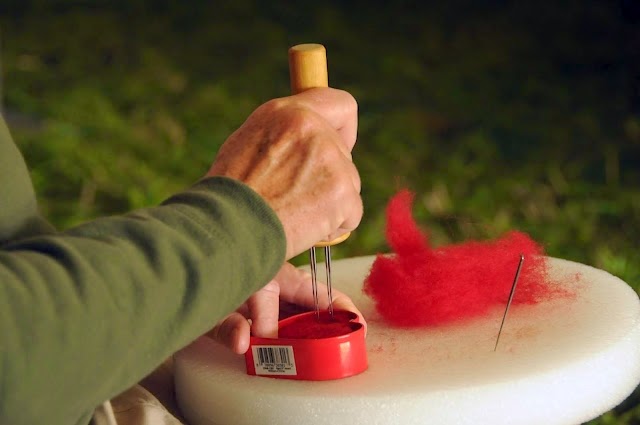 |
| My pond this summer. |
I hope this story will inspire you to attempt to install a pond by
yourself, even if you’ve never done anything like it before!
One of the things I love most in my yard, other than Imax, the llama,
who has taken up residency there, or my Austrian pine tree that I planted 10
years ago, is my pond. When we had been
looking for land to purchase, we had looked at so many tracts of land that had
existing ponds (these ponds were an acre or bigger!). At the time, we were concerned
with the horses using the ponds, snapping turtles claiming their domain, and
the extra work and expense of fencing the perimeter of the pond, so it didn’t
seem worth it. So, instead we purchased
acreage without a water source. When I had
lived in Florida, just a few years before, I had a small backyard pond that the
raccoons seemed to think was the neighborhood sushi bar! I frequently found
remnants of fish on the deck! It wasn’t
big or deep enough to keep the fish safe. So, even though we lived a few blocks
from the Atlantic Ocean, I dreamed of a quiet pond.
When we bought our land in Kentucky, I had a small, pre-molded,
kidney-shaped pond (bigger than the one I had in Florida) that I placed into
the ground even before they were finished building the home! In it I had fish, flowers, and a small
fountain; I even heated it in the winter. I “liked” it, but not really “loved” it.
Within the second day of moving in, I began to dream of what I wanted my real pond
to be like.
Fast forward several years and I finally thought, “What am I waiting
for?!”
A good friend with a bobcat came and dug the hole to match the pond
size that I had wanted. He dug it one
weekend with the expectation that within the next few weeks I’d get around to
installing the liner, etc. That was three summers ago.
 |
| Early pond. |
Now, it just so happened that just a few days later, during that very
same summer, Imax broke his leg. At the time, he was living in a paddock just
for him (not in my yard). He had wrestled at the fence with another male llama,
and had tumbled over the fence into a water trough. During the tumble, he had
gotten his leg caught between the planked fencing that also has wire grids. The
vet came and wanted to “put him down”. But, I was forceful in telling him I
wanted to at least give it a chance to heal.
The break had been below the knee joint and Imax didn’t put stress on
that bone during his transitioning from getting up, to getting down. Llamas are
ruminant animals, so they need those extended periods of time every day to sit
and just ruminate. The vet agreed to put the cast on and Imax moved into the
yard so that I could monitor him more closely and keep bugs/flies away from the
cast.
 |
| The pond my first summer. |
 |
| The pond with day lilies and a few solar lights. |
Needless to say, I didn’t put the pond in that summer. I didn’t want Imax falling into water, nor
did I want him getting his cast wet playing at the water’s edge. So, the hole
sat there. So did Imax. By the way, he healed and is as good as new!
 |
| Pond with thin layer of ice. I have a heater for it to keep fish alive. |
The next spring, I decided to finally finish the pond. I wasn’t worried about Imax. I knew he had gotten accustomed to my yard
and knew the hole in the ground was there.
I was going to put him back into his paddock after the cast came off
(summer before), but I’d gotten so used of him paling around with me, that I
couldn’t bear to not have him there. So,
Imax stayed in the yard, and I began work on the pond.
This time we had to manually dig!
We dug out the clay, dirt, debris, and whatever else you want to call it!
We dug back out what the rain and snow had managed to slide in during a year’s
time. Kentucky clay can be hard as rock.
We worked for about a day and got it how we had wanted it. It was about 48” deep in the middle and about
30”deep everywhere else. It was also 12’
long x 10' wide.
 |
| Visitors to the yard, stop for a drink. |
The next day we got an early start and made sure our work was
level. I used a fence plank 16 feet long
and laid it across the pond. Then put my
level on that to see how it faired. It was pretty good for a first attempt.
Nothing had begun to grow in the hole during a year’s time, so I
wasn’t too worried about roots nor sprouts finding their way through the liner.
So, I didn’t put down sand.
We spread the liner over the pond, and began in the deepest part
giving a little extra of the fabric to allow for the water to weight it down.
We added a bit of water to help smooth it around.
 |
| Little "oiseaux" (birds-gold finch) stopping by for a drink! Adorable! |
After we were satisfied with the liner in the deepest part, we moved
to the next ledge. We smoothed that and
continued to fill with water. The weight begins to pull on the liner and takes
as much as it needs. That’s why it is
important not to try to fix the edging until after the pond is almost entirely
filled.
At this point, even before I added the rocks around the edge of the
pond, I installed the pump and filter. I used a small filter but one that was still
strong enough to pump a few hundred gallons of water per hour. I had wanted a
waterfall, but didn’t have enough large rocks to build it, so for that first
year, I put a whiskey barrel next to the pond and ran the tube from the pump,
out of the pond between a few stones, drilled a hole through the middle of the
whiskey barrel, and then out the other side so that the water flowed back down
over a few rocks. It was my inexpensive
and easy fix to a “waterfall like” feature. We let the water sit in the pond
for a week…….
 |
| Water Hyacinth |
 |
| Granddaddy bullfrog! EEe-rup! |
……Then, the fun began! I was fairly certain that the chlorine would
have dissipated and that it was safe for the fish to go in. So, we began
draining the pre-molded pond and started catching the fish. It was a crazy and chaotic task, but we did
it with relative ease! These fish had
been purchased for around 25 cents at a “big box” store several years
before. They’d grown quite big and it
was because of them that I built the new pond!
I felt they needed a much bigger space!
 |
| Using the whiskey barrel to hide the water tube from the pump |
Next came the planting. We drudged them up from the bottom of the pond
covered in muck. We rinsed them off and
checked them out. This also gave me the
opportunity to divide the tubers. They
were so HEAVY and large!!
After all those were in place, I finally finished the edging. We laid rocks and dug up extra daylilies from
a flower bed. We placed them around the
pond in an effort to achieve “instant naturalizing”!
****
 |
| Flog with the water lily. |
This has been the second summer with the pond. It is right outside of the dining room window,
so I watch as birds come and bathe in the waterfall each day. I see frogs sit
on the lily pads, rabbits come and stand on the rocks and lean forward to
drink. I even see frog eggs floating in
clusters on top of the water and baby fish swimming below the surface. I have added more rocks around the edge. I’ve
removed the daylilies- I felt they kept me from getting as close as I’d like to
the pond. I still have more things planned
for the pond, even to the point that I’d love an even bigger one, but for now, they*
are all happy; therefore, I am happy.
(*fish, frogs, plants, birds, dragonflies, rabbits, Imax, butterflies,)
 |
| One of the many goldfish! |
If you have a water feature in your yard,
please share a comment or two!
 |
| Water Lily blooms last a only a few days; however, they are constantly sending up new pods. The lilies bloom all summer long! |








































